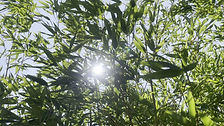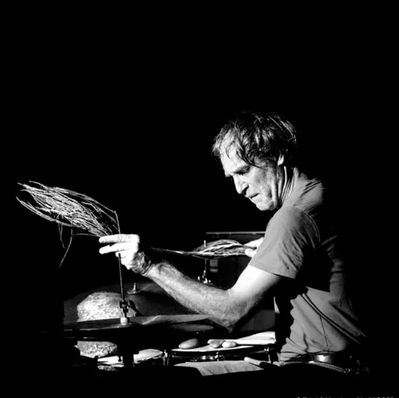
Toma Gouband
.•°•.



"Let's listen to the bells suspended at various heights swing and ring, is that polyrhythm? Let's listen to the flow of a stream and the wind in the foliage, is that polyrhythm? Listening to the heartbeat and the movement of breathing, is that polyrhythm? Let's watch the clouds high and low, is that? Let's listen to the birds and while walking, listen to the footsteps in the fallen leaves, is that? Listening to a child speak at the same time as an adult, is that? Let's imagine the same dance, or steps at the same speed, one unfolding on a train traveling at 100 km/h, the other on solid ground, is that? Let's imagine this same scene and add the image of this scene on our planet in double movement, rotating on itself and around the sun: is that polyrhythm? What is the common denominator between two elements? Let's imagine the aging of a rock, a tree, a bird, a flower, a butterfly, and imagine our own aging, all simultaneously, then add the aging of the sun: is that polyrhythm? Let's imagine the cycle of seasons, the day/night cycle, and the cycle of the moon, is that? Let's imagine all cosmic cycles simultaneously: is that polyrhythm?"
Toma.




Toma Gouband : The Stone Whisperer and Master of Polyrhythm
Toma Gouband (born November 15, 1976, in Manosque, France) is a pioneering French drummer, musician, improviser, inventor, and researcher. He is renowned for his innovative work with natural materials, particularly stones, which he uses to create lithophones and explore the resonance of the earth.
Gouband's artistic approach combines structured composition with improvisation, often focusing on site-specific contexts to create immersive, ritualistic sonic experiences. His work is deeply informed by his profound research into the mathematical underpinnings of rhythm and his exploration of polyrhythms.
Mastering the Lithophone and Natural Instrumentation
Following a transformative experience in a Baka Pygmy village in Cameroon, Gouband dedicated himself to mastering the lithophone—an ancient instrument that produces sound through the vibration of carefully selected resonant stones. Derived from the Greek words 'lithos' (stone) and 'phone' (voice or sound), the lithophone is central to his unique sound.
Gouband meticulously selects stones for their unique sonic qualities, bridging ancient practices with contemporary sound exploration. He has also developed "vegetal lithophones," integrating plants and other natural elements to broaden his sonic palette. Since 2008, Gouband has focused on solo performances that highlight his mastery of lithophones and branches, creating deep sonic connections to the environment.
The Mathematics of Rhythm
Gouband’s artistic practice is strongly influenced by his fascination with numbers, proportions, and polyrhythms. He has developed arithmetic and geometric systems based on modular mathematics to understand and visualize these rhythmic interactions. His research observes the ubiquitous presence of polyrhythms in both natural and celestial processes.
This deep understanding allows him to create compositions characterized by a tension between structured rhythms and organic processes. Gouband is currently working on a comprehensive book about polyrhythms.
Creative Partnerships and Collaborations
Gouband is part of the Astropi collective and has cultivated extensive collaborations throughout his career. He has collaborated with a diverse array of musicians and improvisers, including:
Evan Parker, Michel Doneda, Magic Malik, Eve Risser, Jasper Stadhouders, Bram Stadhouders, Bert Cools, Indrė Jurgelevičiūtė, Sylvain Darrifourcq, Karl Neagelen, Matthieu Prual, Gabriel Lemaire, Carole Robinson, Maïlys Maronne, Peter Evans, Matt Wright, Juan Parra, Alain Angeli, Xavier Faro, Will Guthrie, Michael Moore, Julien Boudard, Audrey Chen, Joris Rühl, Ruben Machtelinckx, Fredrik Rasten, Frederik Leroux, Santiago Quintans, Robin Verheyen, Rosa Fratrason, Iwana Masaki, Elise Caron, Nils Ostendorf, Birgitte Lyregaard, Mathieu Donarier, Karsten Hochapfel, Angel Bat Dawis, Philippe Foch, Hubert Dupont, Aurelie Maisonneuve, Ignacio Gomez, Vincent Moon, Philippe Lauzier, Christophe Havard, Kana Nakamura, Aymeric Avice, Olivier Lété, Julien Padovani, Richard Compte, Guillaume Orti, Prune Bécheau, Christian Pruvost, Jean Luc Guionnet, Sophie Agnel, Sakina Abdou, Marta Waleris, Selma Doyen, Patrick Inguenau, Stephane Thidet, Benoît Delbecq, Nelson Veras, Aino Peltomaa, Sylvaine Hélary, Brice Soniano, Harmen Fraanje, Mari Kvien Brunvoll, Joachim Badenhorst, Jozef Dumoulin, Bruno Chevillon, Antonin Tri Hoang, Georges Dimitriu, Tobias Delius, Elisabeth Coudoux, Tarek Atoui and Kim Myhr.
Installations and Education
Gouband's artistic vision extends to sound installations. His notable installation, “Ondulo,” features 400 suspended terracotta bells activated by natural elements like air and water currents.
He regularly conducts workshops focused on experimentation and deep listening, encouraging participants to explore the sonic potential of materials found within their own landscapes. His teaching emphasizes a generative approach to composition.
Critical Reception
Toma Gouband has received critical acclaim for his original approach to percussion, incorporating environmental awareness, experimentalism, and a deep engagement with polyrhythms. His work is often described as immersive, experiential, and viewed as a ritual or ceremony.
Selected Discography
-
Par 4 chemins (with Harmen Fraanje, Brice Soniano) – Cristal records, 2004
-
1RDR (with Magic Malik, Harmen Fraanje, Brice Soniano) – Cristal records, 2007
-
Balance des blancs (with Kim Myhr, Benoît Delbecq, Nils Ostendorf) – Sofa, 2009
-
Courant des vents (solo) – Psi, 2011
-
Trance Map (with Evan Parker, Matt Wright) – Psi, 2010
-
As the wind (with Evan Parker, Mark Nauseef) – Psi, 2014
-
Sambu (with Bah Moody, Arthur Narcy, Roman Bestion, Antoins Passet) - Cristal records, 2014
-
1>0 (with Benoît Delbecq, Nelson Veras) – Astropi, 2016
-
Orka noise unit (with Jozef Dumoulin, Antonin Tri Hoang, Sylvaine Hélary, Bruno Chevillon) – Yolk, 2018
-
Fenêtre Ovale (with Eve Risser, Joris Ruhl, Amaryllis Billet, Karl Naegelen) – Umlaut, 2017
-
Lagoon (with Roman Bestion) – Astropi, 2019
-
Sans titre #1 (with Matthieu Prual, Dicise, Mathias Delplanque, Gabriel Lemaire) – Mouflon, 2019
-
Jardin des reminiscences (with Aurelie Maisonneuve, Christophe Havard, Fabrice Arnaud Cremon) – Athenor, 2019
-
Porous structures (with Ruben Machtelinckx, Joachim Badenhorst, Bert Cools) - Aspen 2019
-
Un peu plus loin (with Juan Parra, Christophe Havard, Roman Bestion, Matt Wright, Stephane Thidet) – Astropi, 2020
-
Vitesses approchantes (with Karl Naegelen, Sylvain Darifourq) – Athenor, 2021
-
Phonogravie (with Rosa Parlato) - Petit Label, 2022
-
Bestiaire#1 (with Mathieu Donarier, Eve Risser, Karsten Hochapfel) - BMC, 2022
-
Ostrakinda (with Olivier L’été, Aymeric Avice) – Jazzdor, 2022
-
Hammer, roll & leaf (with Sakina Abdou, Marta Waleris) - Relative Pitch records, 2024
-
Porous structures II (with Ruben Machtelinckx, Toma Gouband, Frederik Leroux, Fredrik Rasten) Aspen 2024
-
Véjula (with Bert Cools, Indrė Jurgelevičiūtė) - Stroom, 2024
-
La rencontre (with Lionel Malric, Brice Soniano) - Astropi, 2025





